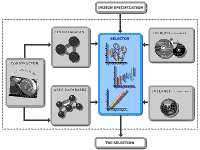| enginuity |
|
home | contents | previous | next |
Select company
In this age of information overload, anything that can help in the selection of the best product for a given application is bound to be welcomed with open arms. Nowhere is this more relevant than in the design of new equipment. Designers are presented with an endless choice of materials and manufacturing processes. What to choose? Has anyone tried this before? Did it work? The Cambridge Engineering Selector (CES) is designed to help with just these types of questions. Developed over a number of years by Professor Mike Ashby and Dr David Cebon, the selector is now being marketed by their company, Granta Design.
David Cebon explains: "We make decisions every day based on some sort of selection criteria: whether it be choosing a new toaster, car or torch battery. Purchases generally involve the use of criteria such as price, function, aesthetic qualities and performance. For engineers designing a product the choices are similar but far more extensive. Traditionally, engineers have relied on experience to make the right choices, but even the best informed can nowadays only know a fraction of the available information."

The CES uses a graphical methodology pioneered by Professor Mike Ashby, to optimise selection of materials and processes from a vast database which includes the world wide web. "The problem is that there are literally tens of thousands of materials, thousands of standard structural shapes, and hundreds of manufacturing processes to choose from," says Mike Ashby. "Furthermore, engineering design criteria are becoming increasingly complex - with intensifying pressure to increase system performance, reduce costs and weight, and reduce environmental impact".
Very often all the information required to make the best choices is available, but is difficult to find. The Engineering Selector can be customised for individual companies to search their own in-house libraries and reports for relevant information, as well as targeting relevant on-line information on the web or their corporate intranet. It can be crucial in bringing relevant information about failures or previous experience to the attention of the designers.
"The software is extremely versatile," says David Cebon. "We have even used it to produce selection systems for garden plants and for general-purpose batteries. It is used by hundreds of universities, world-wide for teaching purposes and is gaining increasing popularity in industry." A case study demonstrating how the selector can be used to design a flywheel is shown on our celebratory web site.
Further information on the Cambridge Engineering Selector and a free demonstration disc are available from David Cebon or Granta Design.
Schools' Selection
The selection chart approach has also been adapted by Dr Hugh Shercliff and Dr Andrew Lovatt for teaching materials as part of the physics and design technology syllabus in schools. Details can be found on our web site.
| number 9, July 2000 | home | contents | previous | next |